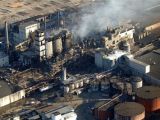And not just by eating it, but by blowing up in your face as well! What are the chances of that ever happening? Well, I was just about to say none, but the fact is that a sugar explosion happened a week ago at the Imperial Sugar Company refinery in Port Wentworth, killing six people, injuring seventeen and severely damaging the structure of the facility. The force of the explosion was so powerful that it stripped away sections of the massive refinery all the way to the steel girders that made up the skeleton of the plant.
Still don't believe me? Google it!
The fact that we are all forgetting here is that sugar is relatively highly flammable. You probably had some bad experiences in the kitchen with caramelized sugar catching fire. Marshmallows are another good example that sugar is flammable. However, in every-day life, sugar doesn't explode very often does it? Then, what caused the explosion at the sugar refinery last week?
Sugar dust. Sugar dust is very volatile, and can be found all over the place in a sugar refinery. If disturbed and spread into the atmosphere, it can easily determine an explosion when encountering an open flame. Between 1980 to 2005, only in the U.S. alone took place about 281 similar incidents, when sugar caught fire and exploded, killing 119 people. However, until now, they all were triggered by other materials, such as dust or wood.
Sugar is an organic material and, as any organic material around, it burns with relative ease. Sugar dust burns through a series of chain reactions that take place instantaneously. As it is lit, sugar interacts with oxygen in the air, process which is followed by a release of energy. Depending on the enclosure of the space you are in, the burn can quickly turn into an explosion, as the compression released by the sugar dust particles expands the volume of air in the respective space.
Sometimes, the explosion is formed of two components. An initial explosion and a second one, due to the fact that the shock wave of the first can unsettle more sugar dust into the air. Dust particles need to be less than 420 microns across to pose a threat, and even small quantities present significant explosion hazard! Thus, next time you go into the kitchen, remember you have a potential bomb in your house!

 14 DAY TRIAL //
14 DAY TRIAL // 
